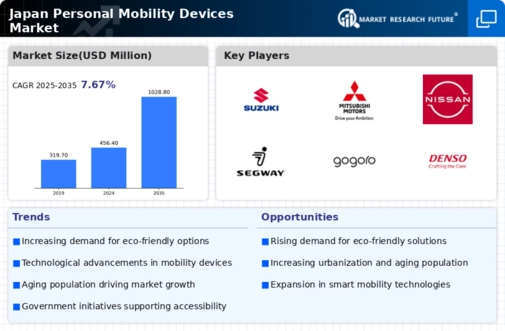Aging Population and Mobility Needs
Japan's aging population is a critical driver for the personal mobility-devices market. As the demographic shifts, the demand for mobility solutions tailored to the elderly increases. Approximately 28% of Japan's population is over 65 years old, necessitating devices that enhance independence and mobility. This demographic trend indicates a growing market for personal mobility devices that cater to the specific needs of older adults, such as ease of use, safety features, and compact designs. The personal mobility-devices market is likely to see innovations aimed at improving accessibility and comfort for this segment, potentially leading to increased sales and market growth.
Urbanization and Congestion Challenges
Rapid urbanization in Japan has led to increased congestion in metropolitan areas, driving the demand for personal mobility devices. With urban populations projected to rise, the need for efficient and compact transportation solutions becomes paramount. The personal mobility-devices market is responding to this challenge by offering alternatives that alleviate traffic congestion and provide last-mile connectivity. For instance, electric scooters and compact electric vehicles are gaining traction as practical solutions for navigating crowded urban environments. This trend suggests a potential increase in market penetration as consumers seek convenient and space-efficient mobility options.
Environmental Awareness and Sustainability
Growing environmental awareness among Japanese consumers is significantly influencing the personal mobility-devices market. As concerns about carbon emissions and pollution rise, there is a marked shift towards eco-friendly mobility solutions. The market is witnessing an increase in demand for electric and hybrid mobility devices, which are perceived as sustainable alternatives to traditional vehicles. This shift is supported by government initiatives promoting green technologies, which may further enhance market growth. The personal mobility-devices market is likely to expand as consumers prioritize sustainability in their purchasing decisions, potentially leading to a broader acceptance of electric mobility solutions.
Technological Advancements in Mobility Solutions
Technological advancements are reshaping the personal mobility-devices market in Japan. Innovations in battery technology, connectivity, and smart features are enhancing the functionality and appeal of mobility devices. For instance, the integration of IoT technology allows for real-time tracking and improved user experience. As these technologies evolve, they are likely to attract a broader consumer base, including tech-savvy individuals seeking modern mobility solutions. The personal mobility-devices market is expected to benefit from these advancements, as manufacturers invest in research and development to create more efficient and user-friendly products.
Government Policies and Infrastructure Development
Government policies aimed at enhancing transportation infrastructure are pivotal for the personal mobility-devices market. Initiatives to develop dedicated lanes for electric scooters and bicycles, along with subsidies for electric mobility devices, are encouraging adoption. The Japanese government has recognized the importance of sustainable transport solutions, which may lead to increased funding for infrastructure projects that support personal mobility devices. This supportive environment is likely to stimulate market growth, as consumers gain access to improved facilities and incentives for using personal mobility devices.

















Leave a Comment